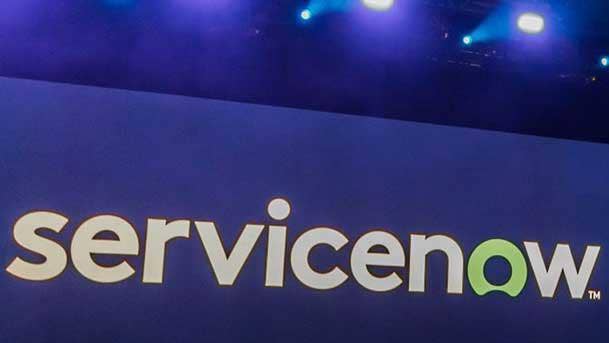ServiceNow CEO Bill McDermott: ‘We’re In A Market Of One’
McDermott says his company is the workflow automation market leader, one that is on its way to becoming a $15 billion SaaS powerhouse by building a “platform of platforms.”

Simplifying The Enterprise
Enterprises traditionally have myriad systems, each with its own processes. Think human resources, incident or change management, sales, software and hardware management, DevOps, and a host of other systems, all packaged neatly in their own silos with little or no communication between them. And while this may have been fine for most companies in the past, the speed at which businesses respond to ever-changing customer requirements means that siloed systems become a headwind to the flexibility required in a modern corporation.
Enter ServiceNow. Founded in 2004, the company invested early in bringing all of a company’s disparate workflows onto a single platform, the Now platform, to automate the associated process and make a business more responsive to change. And it does so by bringing a company’s existing processes onto the Now platform as much as possible to let them continue to benefit from legacy investments.
Bill McDermott, president and CEO of Santa Clara, Calif.-based ServiceNow, calls his company the workflow automation market leader, one that is on its way to becoming a $15 billion SaaS powerhouse by building a “platform of platforms.”
“Businesses are tired of the same old story of doing one thing well in one department with an island of automation,” he said. “They want to put it all together in a strategic platform.”
That idea of automating disparate workloads and processes onto a single platform makes ServiceNow a unique company, McDermott said. “I’m saying there’s only one company that has a hyperautomation platform that does all of those things on one platform with a consumer-grade experience and a pure-play design for the cloud,” he said of ServiceNow.
Here’s more of what McDermott had to say about ServiceNow and the way he sees it transforming businesses.

What is ServiceNow? How do you define it?
ServiceNow is the workflow automation market leader. Essentially, it’s a platform company, and we enable businesses to truly work differently and work better. There are numerous examples that I can give you of that, but workflow automation market leader would be the platform story behind ServiceNow.
Who are your primary competitors?
ServiceNow is in a market segment of one. We are the company that realized you had to make work better for people. Because if you look at the systems of record and the various changes that came about in the enterprise in the prior century, everything was very siloed. There were different systems for HR, for CRM, for financials, for data and analytics. And what happened is we have all of these islands of automation in the enterprise, and many of them were in the customer’s own data center or in early stage cloud companies.
[ServiceNow in 2004] created a platform that enabled companies to manage their IT and really think of IT as the business strategy for a company. How do I service the business? How do I manage my assets? How do I manage operations? How do I keep my operations secure? That really became like a control tower. And on the employee side, it became how do I make sure my employees have a consumer-grade great experience by accessing all the services they need to do their job. We were the company that automated that process. ...
The reason we’re in a market of one is we invented a platform that enables IT, the employee experience, the customer experience, and the creator experience to happen on one platform with one architectural design that’s pure-play in the cloud, that operates at a consumer grade, and it scales with the biggest companies in all industries and geographies in the world. That is a segment of one corporation.

Analysts put ServiceNow in the same reports as companies like BMC, Microsoft, IBM, Atlassian or SAP, yet you call this a ‘segment of one.’
I say we’re the ‘platform of platforms’ because all those other platforms do one thing very well. One of them does financials very well. Another might do IT service OK. Another one might do something in developer operations OK. I’m saying there’s only one company that has a hyperautomation platform that does all of those things on one platform with a consumer-grade experience and a pure-play design for the cloud. So yes, you’ll have independent research that’ll say the companies you mentioned will compete with ServiceNow on one dimension, but what customers are more and more realizing and what partners are obviously betting on because there’s many of them now that have billion-dollar plans with ServiceNow, is that businesses are tired of the same old story of doing one thing well in one department with an island of automation. They want to put it all together in a strategic platform.
What’s stopping someone else from building a similar platform to bring all the different islands of automation together?
Anybody can do anything they want, and that’s the beautiful part of being in a free market economy where innovation is possible. And I believe competition is a great thing because it just inspires us to do even better. But you know, these things don’t happen overnight. So anybody who wanted to do that would have to literally start with a clean sheet design like we did and innovative platforms that could scale across all of those domains, which is really hard to do. If it wasn’t really hard to do, ServiceNow wouldn’t have become the global sensation that it is. Yes, of course they could do it. The question is what would the impact be on their core business as they try to catch up with us. This is our core, and we’re accelerating our innovation with billions in R&D. And unlike others who have basically grown through M&A, we’re doing it purely organically.

Does ServiceNow have an acquisition strategy?
Organic growth is working here is because we’re putting so much into R&D and the expertise of our proud engineering heritage. I can’t find a company that I could buy that wouldn’t be dilutive to either my revenue or my margin story. So why would I buy any of them? That’s the real issue. [We] look for great talent in the market and a category that we care a lot about. We did buy some AI companies for the talent, not for the revenue. For instance, we felt that having a Turing Award winner, which is the Nobel Peace Prize for AI, was an important reason to acquire Element AI. And we did that. These are small tuck-ins, they’re complementary to our skills and our culture, and that’s where we’ll play.
What is the vision for ServiceNow going forward? What kinds of things are you looking at for 2022 and beyond?
First of all, the market for a cloud-type of automation platform like ServiceNow is at least $1 trillion, according to IDC and Gartner. If you want to just narrow it down to what we’re focused on right now, and just look at the properties that we have on our platform, depending on which research analysts writes the report, it’s about $175 [billion] to $200 billion in market opportunity. So we’re just getting started in terms of capitalizing on our addressable market with our sustained engineering force. So we’re going to be the workflow automation platform market leader for the global economy in all industries and geographies, and all personas across the enterprise, hard stop. This is the defining enterprise software company at the 21st century. It’s become branded within ServiceNow as DESCO21C. That’s job one.
And job two is making sure that we build the most incredible culture on the planet. We were able to hire more than 10,000 people during COVID. We’ll more than double our workforce in the next couple of years. And we have the highest retention rates of employees and customers in the information technology industry, high Net Promoter Score, loyal customers, loyal employees, all part of our hungry and humble culture of winning as a team and really wowing our customers and building something at the highest standards.

How important are channel partners to that vision and to the growth of ServiceNow?
Absolutely essential. We have 10 of the world’s largest ones now. Almost all 10 of them already have at least a billion-dollar ServiceNow aspiration. And some of them have up to a $5 billion aspiration with ServiceNow. We try to form partnerships that really help CEOs out there solve big problems. The CEO community is focused on digital transformation as a long-term solution. They need to solve structural challenges, whether it’s political conflict, supply chain disruption, inflation, all the things around siloed applications and siloed environments. All of this is an elixir for the partner network to help us in industries and geographies and personas. So great partners like Deloitte are teaming up with us to improve business processes from IT to the employee and customer experience. And they’re really driving tremendous ROI. On average, 5X ROI improvement for the customers we jointly serve. Look at Accenture. They work with us to deliver world-class experiences to, for example, veterans [by focusing] our AI capabilities to automate what used to be difficult manual processes to give veterans a great experience. And veterans now take very complex paths from loan originations to how they get their services and medical care all on the ServiceNow platform with customer satisfaction rates near 100 percent. And so all of these partners are mission- critical.
So all of this is really coming together in a beautiful mosaic. I met with a fantastic CEO of one of the largest telco companies in the world where we’re teaming up on 5G and digital trust. It’s one of the big issues that touches security, network services, the services you get on your mobile. And we built out a whole cybersecurity plan with this company to take solutions and be very nimble against attackers and other things because all these siloed tools in the enterprise are presenting tremendous entry point opportunities for attackers. So we put a 360-degree view of customer security in front of us and built a posture for that in real time.

Do you see any change in partner dynamics going forward? Either the way partners are doing business with ServiceNow or the way partners are taking ServiceNow to their customers?
What’s happening out there is customers feel that they have invested billions in their IT and their applications. But what they’re disillusioned by is only 25 percent of them have gotten positive ROI on those investments. And as they think about ServiceNow and the ecosystem thinks about ServiceNow, we’re the company that enables all of those previous investments to be automated, where the customer can now wring the value out of those platforms that they bargained for, and yet they can have one automation platform that spans the enterprise at a consumer-grade level on mobile that gives people incredible services.
So the partner network is saying, ‘Hey, I am going to make the customer happy. I can still keep all the great practices I have with all the other companies that I developed in the 20th century, but I can bring a new step function of productivity, a new form factor of consumer great experiences with all of my customers without harming any of the prior relationships.’ And that’s what ServiceNow enables. You know, 20 percent of productivity in every enterprise goes down the drain with swivel chair losses and people toggling between application sets on computers, smartphones and devices. With ServiceNow, all that goes away. All that turns into instant activity and instant action.
What are some things that you would like to see your channel partners do to be more in tune with the vision you have for them?
I really want them to recognize it’s all about people. Talent is really the difference between thriving and surviving in the 21st century. And we have to close the global skills gap because the closure of that gap is an $11.5 trillion market opportunity by 2028, according to the World Economic Forum. So we have to be attracting and keeping the best talent. But also we need our partners to be an extension of our talent pool because they do 90 percent of the implementations out there, and they have to drive customer satisfaction and innovation and scale. So we’re going to have to do lots of training, lots of skill development, lots of recruiting, and lots of work with our customers to make sure that they are 100 percent satisfied and referenceable and scalable at all times. So really, the No. 1 thing is focus on people, develop that talent, and make sure it’s extraordinarily well prepared for the challenges that our customers are going to face in this century and beyond.

How important is security in the ServiceNow platform?
Instead of having 30 different platforms to solve the security breach issue, have one control tower that seamlessly integrates all of them. So you have real-time visibility across the entire enterprise, and you have one command center that enables you to see in real time on your mobile or on the screen from anywhere in the world what’s going on. Companies are ill prepared for this because they didn’t know at the time that islands of automation will actually give you more vulnerability than will give you security. ServiceNow gives that security. We put it all together on one control tower that will peak everyone’s protection on a exponential level and make much more secure enterprises in a much more secure world.
What kind of R&D is ServiceNow working on and what are some things that we might see new on the platform this year?
We do two different major releases each year, and we name them after cities in the world. This quarter, it’s San Diego, and we’re going big on RPA [robotic process automation]. We’re going big on process mining. We extended all the things that we’re doing on deep machine learning and AI and AIops, and new breakthroughs in all dimensions around the direct-to-consumer employee experience. And a focus on the creator, which some people call the citizen developer, but it’s the low-code platform.
Remember one thing about ServiceNow: It’s like a Tesla because as we constantly bring cloud-based innovation, customers can consume the innovation without any disruption. Our invisible upgrades do not require our customers to go through an upgrade cycle or shut down their operations. ... It’s an instant-on implementation upgrade, completely invisible. We’re the only one in the enterprise that can do it.